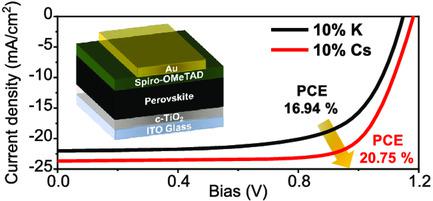Our official English website, www.x-mol.net, welcomes your
feedback! (Note: you will need to create a separate account there.)
Efficient Hybrid Mixed‐Ion Perovskite Photovoltaics: In Situ Diagnostics of the Roles of Cesium and Potassium Alkali Cation Addition
Solar RRL ( IF 6.0 ) Pub Date : 2020-07-06 , DOI: 10.1002/solr.202000272 Ming-Chun Tang 1, 2, 3 , Yuanyuan Fan 4 , Dounya Barrit 1, 5 , Ruipeng Li 6 , Hoang X. Dang 7 , Siyuan Zhang 2, 8 , Timothy J. Magnanelli 2 , Nhan V. Nguyen 2 , Edwin J. Heilweil 2 , Christina A. Hacker 2 , Detlef-M. Smilgies 9 , Kui Zhao 4 , Aram Amassian 1, 7 , Thomas D. Anthopoulos 1
Solar RRL ( IF 6.0 ) Pub Date : 2020-07-06 , DOI: 10.1002/solr.202000272 Ming-Chun Tang 1, 2, 3 , Yuanyuan Fan 4 , Dounya Barrit 1, 5 , Ruipeng Li 6 , Hoang X. Dang 7 , Siyuan Zhang 2, 8 , Timothy J. Magnanelli 2 , Nhan V. Nguyen 2 , Edwin J. Heilweil 2 , Christina A. Hacker 2 , Detlef-M. Smilgies 9 , Kui Zhao 4 , Aram Amassian 1, 7 , Thomas D. Anthopoulos 1
Affiliation

|
Perovskite photovoltaics have made extraordinary progress in power conversion efficiency (PCE) and stability due to process and formulation development. Perovskite cell performance benefits from the addition of alkali metal cations, such as cesium (Cs+) and potassium (K+) in mixed‐ion systems, but the underlying reasons are not fully understood. Herein, the solidification of perovskite layers is studied, incorporating 5%, 10%, to 20% of Cs+ and K+ using in situ grazing incidence wide‐angle X‐ray scattering. It is found that K+‐doped solutions yield nonperovskite 4H phase rather than the 3C perovskite phase. For Cs+‐doped formulations, both 4H and 3C phases are present at 5% Cs+, whereas the 3C perovskite phase is formed in 10% Cs+‐doped formulations, with undesirable halide segregation occurring at 20% Cs+. Postdeposition thermal annealing converts the intermediate 4H phase to the desirable 3C perovskite phase. Importantly, perovskite layers containing 5% of Cs+ or K+ exhibit a reduced concentration of trap states and enhanced carrier mobility and lifetime. By carefully adjusting Cs+ or K+ concentration to 5%, perovskite cells are demonstrated with a ≈5% higher‐average PCE than cells utilizing higher cation concentrations. Herein, unique insights into the crystallization pathways toward perovskite phase engineering and improved cell performance are provided.
中文翻译:

高效混合钙钛矿混合离子光伏技术:铯和钾碱金属阳离子添加作用的原位诊断
由于工艺和配方的发展,钙钛矿光伏技术在功率转换效率(PCE)和稳定性方面取得了非凡的进步。钙钛矿电池的性能受益于在混合离子系统中添加铯(Cs +)和钾(K +)等碱金属阳离子,但其根本原因尚不完全清楚。在本文中,研究了钙钛矿层的凝固过程,利用原位掠入射的广角X射线散射法,结合了5%,10%到20%的Cs +和K +。发现掺K +的溶液产生非钙钛矿4H相,而不是3C钙钛矿相。对于Cs +掺杂的配方,4H和3C相均以5%Cs存在+,而3C钙钛矿相是在10%Cs +掺杂的配方中形成的,在20%Cs +时会发生不希望的卤化物偏析。沉积后的热退火将中间的4H相转化为所需的3C钙钛矿相。重要的是,含有5%Cs +或K +的钙钛矿层的阱态浓度降低,载流子迁移率和寿命提高。通过仔细调整Cs +或K +在钙离子浓度达到5%的情况下,钙钛矿细胞的平均PCE比利用较高阳离子浓度的细胞高5%左右。在本文中,提供了对钙钛矿相工程和改善细胞性能的结晶途径的独特见解。
更新日期:2020-07-06
中文翻译:

高效混合钙钛矿混合离子光伏技术:铯和钾碱金属阳离子添加作用的原位诊断
由于工艺和配方的发展,钙钛矿光伏技术在功率转换效率(PCE)和稳定性方面取得了非凡的进步。钙钛矿电池的性能受益于在混合离子系统中添加铯(Cs +)和钾(K +)等碱金属阳离子,但其根本原因尚不完全清楚。在本文中,研究了钙钛矿层的凝固过程,利用原位掠入射的广角X射线散射法,结合了5%,10%到20%的Cs +和K +。发现掺K +的溶液产生非钙钛矿4H相,而不是3C钙钛矿相。对于Cs +掺杂的配方,4H和3C相均以5%Cs存在+,而3C钙钛矿相是在10%Cs +掺杂的配方中形成的,在20%Cs +时会发生不希望的卤化物偏析。沉积后的热退火将中间的4H相转化为所需的3C钙钛矿相。重要的是,含有5%Cs +或K +的钙钛矿层的阱态浓度降低,载流子迁移率和寿命提高。通过仔细调整Cs +或K +在钙离子浓度达到5%的情况下,钙钛矿细胞的平均PCE比利用较高阳离子浓度的细胞高5%左右。在本文中,提供了对钙钛矿相工程和改善细胞性能的结晶途径的独特见解。











































 京公网安备 11010802027423号
京公网安备 11010802027423号